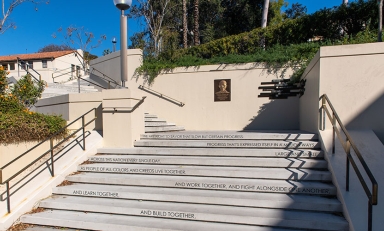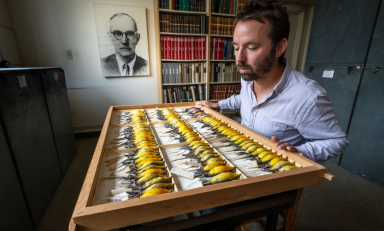The National Science Foundation has awarded $1.16 million in grants to six Occidental College biology, chemistry, and physics professors to continue their research into the mysteries of dark matter and the building blocks of cell structure.
Physics professor Daniel Snowden-Ifft was awarded a three-year $840,000 grant to continue his research to detect dark matter, and chemistry professor Eileen Spain and biology professors Renee Baran, Gretchen North, Joseph Schulz andShana Goffredi received a $318,771 grant to buy a laser-scanning confocal microscope, which allows high-resolution images to be captured from lightly prepared or living material.
"We are excited not only because the confocal microscope will allow us to see inside living cells, but also because the images themselves can be quite beautiful, showing one of the close connections between science and the visual arts," North said.
One advantage of confocal microscopy is that multiple sections through a specimen can be obtained, allowing 3-D reconstruction of its interior. In combination with fluorescent tags, individual proteins and other molecules can be precisely located within cells, providing information about patterns of gene expression, according to North. The microscope will be used to support faculty and student research in developmental neuroscience, neurophysiology, plant physiology, microbial ecology and the chemistry of microbial biofilms. In addition to research by the five professors, other faculty and more than 40 undergraduate researchers in the biology and chemistry departments will be able to use the instrumentation.
The NSF has funded the Snowden-Ifft's dark-matter work since 1997, and has contributed more than $2.5 million to his pursuit of a highly sensitive and accurate directional dark-matter detector. The professor's project, "Directional Recoil Identification From Tracks," or DRIFT, uses a unique, negative-ion, time-projection chamber to detect dark matter. The project is a collaboration with researchers from the University of New Mexico, Colorado State University, the University of Sheffield (U.K.), and the University of Edinburgh (U.K.).
The NSF grant will help the professor and his colleagues research and design a prototype for a more advanced DRIFT detector, one with 30 times greater volume and sensitivity than currently being used, Snowden-Ifft said, adding that the advantage of this detector lies in its ability to separate dark matter events from garden-variety background events, a real plus in a field plagued by backgrounds.
Occidental's principal role will be to design and build the readout plane for this prototype. Undergraduate students and Snowden-Ifft will carry out this work, which requires painstaking precision. Oxy students built the earlier versions of DRIFT detectors. Not only do they get hands-on knowledge and experience, they're doing work that is generally only available to graduate students. Once finished, the detectors are sent to an underground laboratory in England.
Snowden-Ifft's work is important because although we have made progress in learning about our universe, we have a very long way to go. Research on the cosmos suggests that protons, neutrons and electrons (normal matter) compose only a fraction of the mass density of the universe. The rest, which we detect principally by gravitation, is dark matter, which scientists believe are composed of "weakly interacting massive particles" left over from the Big Bang.
"The discovery of this material would fill an obvious hole in cosmology," said Snowden-Ifft. "It would also, likely, point the way to physics beyond the standard model of particle physics."



